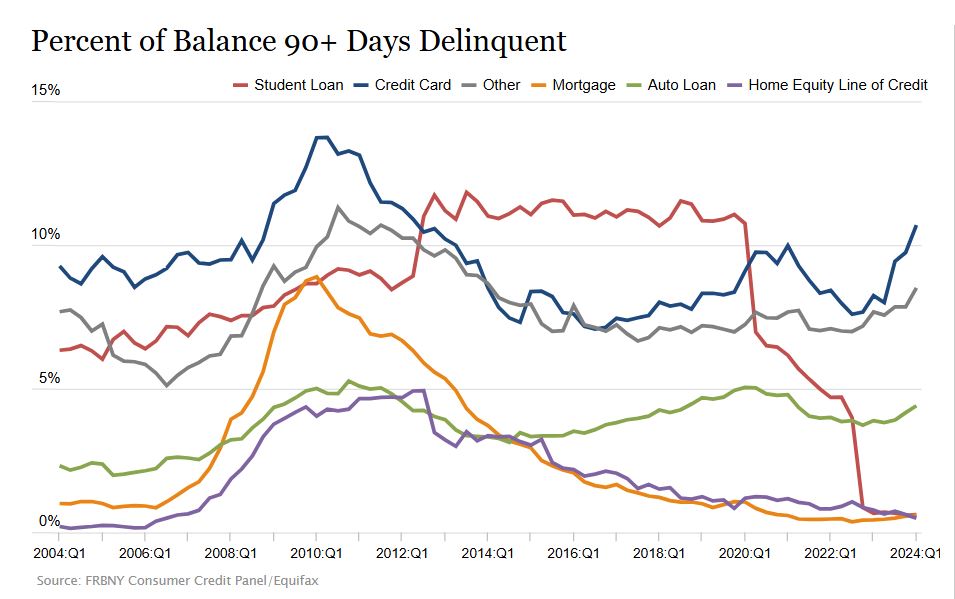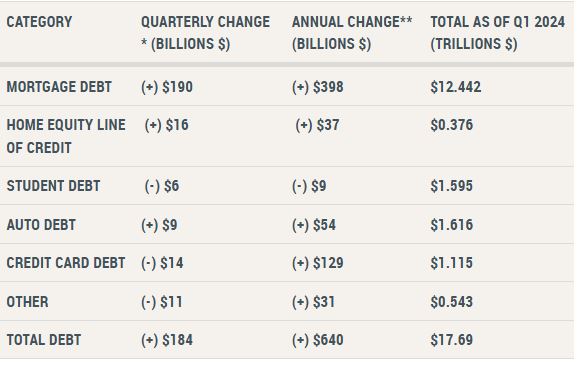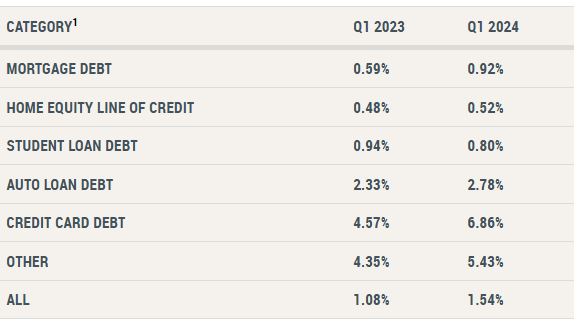Fed Reserve Sees Auto Loan and Credit Card Delinquency Worsening in Q1 2024
“In the first quarter of 2024, credit card and auto loan transition rates into serious delinquency continued to rise across all age groups,” New York Fed
New York, NY – May 14, 2024 – Assumptions of a noticeable seasonal reduction in auto loan and credit card delinquency during the first quarter of 2024 seem to be dead. According to the Federal Reserve Bank of New York, both are on the rise and rising household debt combined with it, are revealing a troublesome trend of continued worsening of financial distress among some households.
NEW YORK — The Federal Reserve Bank of New York’s Center for Microeconomic Data today issued its Quarterly Report on Household Debt and Credit. The report shows total household debt increased by $184 billion (1.1%) in the first quarter of 2024, to $17.69 trillion. The report is based on data from the New York Fed’s nationally representative Consumer Credit Panel.
The New York Fed also issued an accompanying Liberty Street Economics blog post examining credit card utilization and its relationship with delinquency. The Quarterly Report also includes a one-page summary of key takeaways and their supporting data points.

“In the first quarter of 2024, credit card and auto loan transition rates into serious delinquency continued to rise across all age groups,” said Joelle Scally, Regional Economic Principal within the Household and Public Policy Research Division at the New York Fed. “An increasing number of borrowers missed credit card payments, revealing worsening financial distress among some households.”
Mortgage balances rose by $190 billion from the previous quarter and was $12.44 trillion at the end of March. Balances on home equity lines of credit (HELOC) increased by $16 billion, representing the eighth consecutive quarterly increase since Q1 2022, and now stand at $376 billion. Credit card balances decreased by $14 billion to $1.12 trillion. Other balances, which include retail cards and consumer loans, also decreased by $11 billion. Auto loan balances increased by $9 billion, continuing the upward trajectory seen since 2020, and now stand at $1.62 trillion.
Mortgage originations continued increasing at the same pace seen in the previous three quarters, and now stand at $403 billion. Aggregate limits on credit card accounts increased modestly by $63 billion, representing a 1.3% increase from the previous quarter. Limits on HELOC grew by $30 billion and have grown by 14% over the past two years, after 10 years of observed declines.
Aggregate delinquency rates increased in Q1 2024, with 3.2% of outstanding debt in some stage of delinquency at the end of March. Delinquency transition rates increased for all debt types. Annualized, approximately 8.9% of credit card balances and 7.9% of auto loans transitioned into delinquency. Delinquency transition rates for mortgages increased by 0.3 percentage points yet remain low by historic standards.
Household Debt and Credit Developments as of Q1 2024

*Change from Q4 2023 to Q1 2024
** Change from Q1 2023 to Q1 2024
Flow into Serious Delinquency (90 days or more delinquent)

About the Report
The Federal Reserve Bank of New York’s Household Debt and Credit Report provides unique data and insight into the credit conditions and activity of U.S. consumers. Based on data from the New York Fed’s Consumer Credit Panel, a nationally representative sample drawn from anonymized Equifax credit data, the report provides a quarterly snapshot of household trends in borrowing and indebtedness, including data about mortgages, student loans, credit cards, auto loans and delinquencies. The report aims to help community groups, small businesses, state and local governments and the public to better understand, monitor, and respond to trends in borrowing and indebtedness at the household level. Sections of the report are presented as interactive graphs on the New York Fed’s Household Debt and Credit Report web page and the full report is available for download.
- Rates represent annualized shares of balances transitioning into delinquency. Flow into serious delinquency is computed as the balances that have newly become at least 90 days late in the reference quarter divided by the balances that were current of less than 90 days past due in the previous quarter.
Contact
Connor Munsch
(347) 224-1175
Connor.Munsch@ny.frb.org
Fed Reserve Sees Auto Loan and Credit Card Delinquency Worsening in Q1 2024 – Fed Reserve Sees Auto Loan and Credit Card Delinquency Worsening in Q1 2024 – Fed Reserve Sees Auto Loan and Credit Card Delinquency Worsening in Q1 2024
Fed Reserve Sees Auto Loan and Credit Card Delinquency Worsening in Q1 2024 – Delinquency – Credit Union Collections – Credit Union Collectors – Lending – Auto Loan –












Facebook Comments